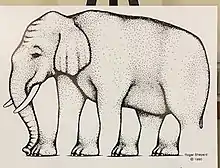فیل شپارد
فیل شپارد، که به آن L'egs-istential Quandary یا فیل غیرممکن نیز میگویند، یک خطای دید از نوع شیء غیرممکن و بر اساس آشفتگی شکل و زمینه است. همانطور که خالق آن راجر شپارد توضیح میدهد:[1]
فیل… به گروهی از اشیا تعلق دارد که واقعاً غیرممکن است، زیرا خود شی بهطور سراسری نمیتواند از قسمت غیر شیء یا پس زمینه جدا شود. قسمتهایی از جسم (در این حالت پاهای فیل) به زمینه تبدیل میشود و بالعکس.

پوستری که فیل شپارد را نشان میدهد (4 legs, 4 feet)

راجر شپارد، روانشناس استنفورد (مارس ۲۰۱۹)، کسی که اولین بار این پارادوکس را منتشر کرد.
تاریخ
شپرد برای اولین بار این پارادوکس دیداری را در کتاب Mind Sights 1990 (صفحه ۷۹) با نام "L'egs-istential Quandary" منتشر کرد."[2] این اولین مدخل در فصل او در مورد «نشدنیهای شکل و زمینه ای» است. نقاشی قلم و جوهر او براساس رویایی است که در سال ۱۹۷۴ دیدهاست و بر روی پیشطرحی که بعد از بیدار شدن کشیدهاست کشیده شدهاست.[2]
تفسیر

توهم بیلوت، یکی دیگر از شکلهای غیرممکن مبتنی برآشفتگی شکل و زمینه است
جستارهای وابسته
منابع
- Shepard, RN (1990). Mind Sights: Original visual illusions, ambiguities, and other anomalies, with a commentary on the play of mind in perception and art. W.H. Freeman and Company. p. 143. ISBN 978-0-7167-2134-5.
The elephant…belongs to a class of objects that are truly impossible in that the object itself cannot be globally segregated from the nonobject or background. Parts of the object (in this case the elephant’s legs) become the background, and vice versa.
- Rock, Andrea (2009). Dream: The Mind at Night: The New Science of How and Why We Dream. Basic Books. p. 137. ISBN 978-0-7867-3919-6.
This drawing, entitled 'L'egs-istential Quandary,' sprang from a visual image that came to scientist Roger M. Shepard just before he awakened one morning in 1974. The quick pencil sketch he made when he awoke became the basis for this ink drawing, for which Shepard holds the copyright.
This article is issued from Wikipedia. The text is licensed under Creative Commons - Attribution - Sharealike. Additional terms may apply for the media files.